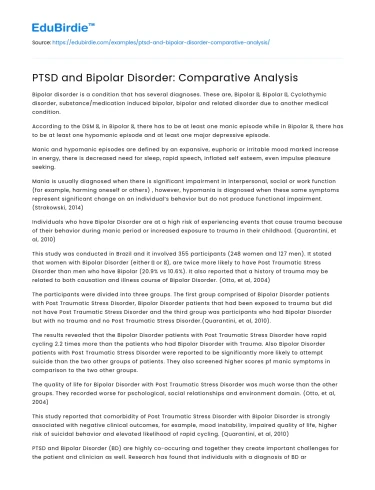Bipolar disorder is a condition that has several diagnoses. These are, Bipolar Ⅰ, Bipolar Ⅱ, Cyclothymic disorder, substance/medication induced bipolar, bipolar and related disorder due to another medical condition.
According to the DSM Ⅴ, in Bipolar Ⅰ, there has to be at least one manic episode while in Bipolar Ⅱ, there has to be at least one hypomanic episode and at least one major depressive episode.
Save your time!
We can take care of your essay
- Proper editing and formatting
- Free revision, title page, and bibliography
- Flexible prices and money-back guarantee
Manic and hypomanic episodes are defined by an expansive, euphoric or irritable mood marked increase in energy, there is decreased need for sleep, rapid speech, inflated self esteem, even impulse pleasure seeking.
Mania is usually diagnosed when there is significant impairment in interpersonal, social or work function (for example, harming oneself or others) , however, hypomania is diagnosed when these same symptoms represent significant change on an individual’s behavior but do not produce functional impairment. (Strakowski, 2014)
Individuals who have Bipolar Disorder are at a high risk of experiencing events that cause trauma because of their behavior during manic period or increased exposure to trauma in their childhood. (Quarantini, et al, 2010)
This study was conducted in Brazil and it involved 355 participants (248 women and 127 men). It stated that women with Bipolar Disorder (either Ⅰ or Ⅱ), are twice more likely to have Post Traumatic Stress Disorder than men who have Bipolar (20.9% vs 10.6%). It also reported that a history of trauma may be related to both causation and illness course of Bipolar Disorder. (Otto, et al, 2004)
The participants were divided into three groups. The first group comprised of Bipolar Disorder patients with Post Traumatic Stress Disorder, Bipolar Disorder patients that had been exposed to trauma but did not have Post Traumatic Stress Disorder and the third group was participants who had Bipolar Disorder but with no trauma and no Post Traumatic Stress Disorder.(Quarantini, et al, 2010).
The results revealed that the Bipolar Disorder patients with Post Traumatic Stress Disorder have rapid cycling 2.2 times more than the patients who had Bipolar Disorder with Trauma. Also Bipolar Disorder patients with Post Traumatic Stress Disorder were reported to be significantly more likely to attempt suicide than the two other groups of patients. They also screened higher scores pf manic symptoms in comparison to the two other groups.
The quality of life for Bipolar Disorder with Post Traumatic Stress Disorder was much worse than the other groups. They recorded worse for pschological, social relationships and environment domain. (Otto, et al, 2004)
This study reported that comorbidity of Post Traumatic Stress Disorder with Bipolar Disorder is strongly associated with negative clinical outcomes, for example, mood instability, impaired quality of life, higher risk of suicidal behavior and elevated likelihood of rapid cycling. (Quarantini, et al, 2010)
PTSD and Bipolar Disorder (BD) are highly co-occuring and together they create important challenges for the patient and clinician as well. Research has found that individuals with a diagnosis of BD are more likely to develop Post Traumatic Stress Disorder than individuals with a diagnosis of Major Depressive Disorder. This is due to difficulties adjusting to post trauma. (Dilsaver, et al, 2007 as cited in Carter, et al, 2017). Just like in the previous study, patients who have Bipolar Disorder with Post Traumatic Stress Disorder have increased suicide risk, increased number of hospitalization, more rapid cycling, lower quality of life and poorer treatment outcome.
The focus of this study is suicide risk among patients with Bipolar Disorder and PTSD. The fact that co-occuring PTSD is also associated with lower quality of life also increases risk for suicide. The research found that PTSD may sometimes go undiagnosed in patients with Bipolar Disorder Ⅰ because the symptoms of PTSD and Bipolar overlap, misdiagnosis is common. (Carter, et al, 2017)
According to this study, the difference in suicide attempts in patients with bipolar Ⅰ and bipolar Ⅱ were not very significant. The study suggests that there is more significance to clinicians to do thorough diagnostic differentials in order to tailor make treatments appropriately as accurate diagnosis of both Bipolar 1 and Post Traumatic Stress Disorder. The study also found that lower quality of life in the participants contributed to increased suicidal risk.
Participants who had bipolar Ⅰ Disorder with co-occuring Post Traumatic Stress Disorder expressed significantly high scores for suicidal ideation. This communicated that effects of PTSD on suicidal ideation is dependent on the type of Bipolar Disorder.
Symptoms that overlap in Bipolar and PTSD such as impulsivity and delusions of grandeur (which are recorded more in bipolar Ⅰ Disorder) increase the risk of suicidal ideation.
This study was conducted using 148 publications, 12 independent meta-analyses were conducted for each of the clinical outcome of Bipolar disorder. This meta-analysis showed that a history of maltreatment in childhood in patients with bipolar is associated is increased severity of manic, depressive and psychotic symptoms and also risk of comorbid PTSD. Also, a history of childhood maltreatment can be an early indicator of bipolar disorder progression. (Blais and Danese, 2016)
Bipolar disorder and Post Traumatic Stress Disorder comorbidity is significantly high. Comorbid PTSD is also an important indicator of worse clinical outcomes in Bipolar Disorder. There is need for proper clinical assessment because there also seems to be an overlap in the diagnosis of these disorders and patients. Proper care of patients with this comorbidity is also vital in order to get proper diagnosis and assess risks thoroughly. With this in mind, there is need for more research on PTSD comorbidity in individuals with Bipolar because it has been noted to be an increased predictor of suicide risk. (Carter, et al, 2017)






 Stuck on your essay?
Stuck on your essay?

